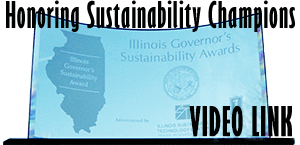ISTC NEWS
Apply for the Illinois Governor’s Sustainability Award Program
Illinois sustainability champions have been recognized every year since 1987 through the Illinois Governor’s Sustainability Awards (IGSA). [In earlier years called the Illinois Governor’s Pollution Preventions Awards]
Applications are now open for the 2016 IGSA, the nation’s longest standing state environmental award program, through which companies, municipalities, and organizations are acknowledged for their efforts for minimizing their environmental impact and having positive economic and societal consequences for their sustainability actions. The award program is a service of the Illinois Sustainable Technology Center, a division of the Prairie Research Institute at the University of Illinois at Urbana-Champaign.
Public and private Illinois organizations statewide are implementing strategies to save money and resources by eliminating wasted energy, water, and material in their manufacturing and other activities. The Illinois Governor’s Sustainability Award is an opportunity to be recognized as a leader in your sector for environmental efficiency and sustainable leadership.
Four recent winners show how they did it in an on-line video profiling Nestle Inc. Jacksonville, Ill; the City of Galena, Ill; a small business, beelove of Chicago; and the City of Arcola.
Applications are available on the IGSA website: http://www.istc.illinois.edu/info/govs_awards.cfm. They will be accepted until 5 p.m. Friday, May 20. Please visit our website, as there are many resources to assist in developing your application, such as case studies, sample applications. Among last year’s winners were Cook County, the Shedd Aquarium, AbbVie Inc., Saratoga Food Specialties, and Western Illinois University. Sponsorship opportunities for the awards ceremony are also available: questions can be referred to istc-govsawards@illinois.edu.
The 2016 Awards Ceremony will be held on Tuesday, Nov. 1, at the Union League Club of Chicago, 65 West Jackson Blvd., Chicago.









